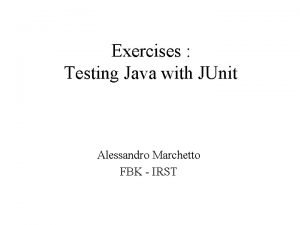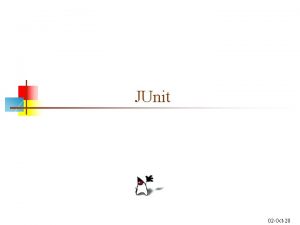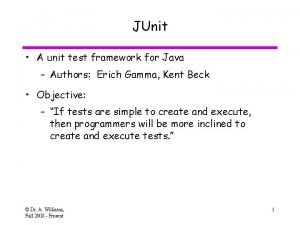JUnit Revisited JUnit n JUnit is a framework


















- Slides: 18

JUnit, Revisited

JUnit n JUnit is a framework for writing unit tests n A unit test is a test of a single class n n n Unit testing is particularly important when software requirements change frequently n n n A test case is a single test of a single method A test suite is a collection of test cases Code often has to be refactored to incorporate the changes Unit testing helps ensure that the refactored code continues to work JUnit helps the programmer: n n define and execute tests and test suites formalize requirements and clarify architecture write and debug code integrate code and always be ready to release a working version 2

What JUnit does n n JUnit runs a suite of tests and reports results For each test in the test suite: n JUnit calls set. Up() n n JUnit calls one test method n n This method should create any objects you may need for testing The test method may comprise multiple test cases; that is, it may make multiple calls to the method you are testing In fact, since it’s your code, the test method can do anything you want The set. Up() method ensures you entered the test method with a virgin set of objects; what you do with them is up to you JUnit calls tear. Down() n This method should remove any objects you created 3

Test classes in Blue. J The class to be tested The class to test it The menu you get when you right-click the test class Use these to run tests Use these to create tests 4

Creating a test class in Blue. J n If you have an existing class, right-click on it and choose Create Test Class n n If your class is named My. Class, the new test class will be named My. Class. Test To create the test class first, just choose New Class. . . and give the test class the name of a future class, with ‘Test’ appended n Later, after you create the class to be tested, you can right-click it and choose Create Test Class n Blue. J will complain that the class already exists, but it will also correctly associate the test class with the class to be tested 5

Creating the set. Up() method n Blue. J has an Object Bench (at the bottom of the main window) n n You can right-click on a test class and choose: n n n You can create objects on the Object Bench by right-clicking on a class and choosing one of its new constructors Object Bench To Test Fixture To Object Bench or Since set. Up() is your code, you can modify it any way you like (such as creating new objects in it) 6

Implementing the tear. Down() method n In most cases, the tear. Down() method doesn’t need to do anything n n n The next time you run set. Up(), your objects will be replaced, and the old objects will be available for garbage collection It doesn’t hurt to set to null the objects you created in set. Up() Like the finally clause in a try-catch-finally statement, tear. Down() is where you would release system resources (such as streams) that might not otherwise be released 7

Recording test cases n An easy way to create a test method is to right-click a compiled test class and choose Create Test Method. . . n Enter the name of the method you want to test; you don’t have to say “test” n n n If you wish, you can copy Test Fixture To Object Bench Use Blue. J to make calls to the method n n Blue. J will capitalize your method name and prefix it with test After each call, Blue. J will tell you its result, and ask you to type in the result you expected n The result can be equal to, the same as, not the same as, null, not null, or equal to (double or float) You can even create a new object to use as a result When you are done click the End button (under Recording) Review the results! n n This is a new feature in Blue. J, and sometimes it produces bad syntax A comma in your expected result will confuse Blue. J 1. 3. 0 8

The structure of a test method n n n A test method doesn’t return a result If the tests run correctly, a test method does nothing If a test fails, it throws an Assertion. Failed. Error n n Hence, a test method just calls some assertion method, any of which may throw an Assertion. Failed. Error The JUnit framework catches the error and deals with it; you don’t have to do anything 9

assert. X methods n n n n n static void assert. True(boolean test) static void assert. False(boolean test) assert. Equals(expected, actual) assert. Same(Object expected, Object actual) assert. Not. Same(Object expected, Object actual) assert. Null(Object object) assert. Not. Null(Object object) fail() All the above may take an optional String message as the first argument, for example, static void assert. True(String message, boolean test) 10

Example: Counter class n For the sake of example, we will create and test a trivial “counter” class n n We write the test methods before we write the code n n n The constructor will create a counter and set it to zero The increment method will add one to the counter and return the new value The decrement method will subtract one from the counter and return the new value This has the advantages described earlier Depending on the JUnit tool we use, we may have to create the class first, and we may have to populate it with stubs (methods with empty bodies) Don’t be alarmed if, in this simple example, the JUnit tests are more code than the class itself 11

JUnit tests for Counter public class Counter. Test extends junit. framework. Test. Case { Counter counter 1; public Counter. Test() { } // default constructor protected void set. Up() { // creates a (simple) test fixture counter 1 = new Counter(); } protected void tear. Down() { } // no resources to release } public void test. Increment() { assert. True(counter 1. increment() == 1); assert. True(counter 1. increment() == 2); } Note that each test begins with a brand new counter public void test. Decrement() { assert. True(counter 1. decrement() == -1); } This means you don’t have to worry about the order in which the tests are run 12

The Counter class itself public class Counter { int count = 0; public int increment() { return ++count; } public int decrement() { return --count; } public int get. Count() { return count; } } n n n Is JUnit testing overkill for this little class? The Extreme Programming view is: If it isn’t tested, assume it doesn’t work You are not likely to have many classes this trivial in a real program, so writing JUnit tests for those few trivial classes is no big deal Often even XP programmers don’t bother writing tests for simple getter methods such as get. Count() We only used assert. True in this example, but there additional assert methods 13

Viewing test results Unexpected errors and exceptions Failed tests If you run a single test, and it is successful, you just get a message in the status line 14

Problems with unit testing n JUnit is designed to call methods and compare the results they return against expected results n n This ignores: n Programs that do work in response to GUI commands n Methods that are used primary to produce output I think heavy use of JUnit encourages a “functional” style, where most methods are called to compute a value, rather than to have side effects n n This can actually be a good thing Methods that just return results, without side effects (such as printing), are simpler, more general, and easier to reuse 15

The GUI problem n The whole point of JUnit is to make testing easy n n n You click a button, and all your tests “just happen” To test a GUI, you have to sit there and interact with the GUI--not good! You can “automate” GUI use by “faking” events n Here’s a starter method for creating your own events: n n public void fake. Action(Component c) { get. Toolkit(). get. System. Event. Queue(). post. Event( new Action. Event(c, Action. Event. ACTION_PERFORMED, "")); } You can explore the Java API to discover how to create other kinds of events 16

The printing problem n If a method does output to the screen or to a file, you want to make sure the output is correct n n How can you capture output? n n n Again, you want to set this up once, and forever after have it all done automatically Rather than always printing on System. out, you can do your printing on an arbitrary Print. Stream The Print. Stream can be passed into methods as a parameter Alternatively, you can redefine System. out to use a different Print. Stream with System. set. Out(Print. Stream) A Java Piped. Output. Stream can be connected directly to a Piped. Input. Stream; this might be helpful Whatever you do, you would like to minimize the effect on the program you are trying to test 17

The End 18
 Math lesson
Math lesson Random sampling over joins revisited
Random sampling over joins revisited Junit.framework.assert
Junit.framework.assert Junit exercises
Junit exercises Mockolás
Mockolás Junit test private methods
Junit test private methods Junit test concurrency
Junit test concurrency Thecoadletter
Thecoadletter Fixture junit
Fixture junit Tdd junit
Tdd junit Junit tutorial eclipse
Junit tutorial eclipse Junit testing
Junit testing Informatica def
Informatica def Junit
Junit Theoretical framework and conceptual framework example
Theoretical framework and conceptual framework example Dispositional framework vs regulatory framework
Dispositional framework vs regulatory framework Theoretical framework example
Theoretical framework example Iso/iec/ieee 42010
Iso/iec/ieee 42010 Theoretical framework
Theoretical framework

































